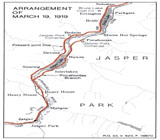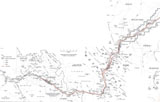The Canadian National Railways
The first phase of development for the new Canadian National Railways under D.B. Hanna’s management involved attention to deferred maintenance. The government advanced large sums of money to the CNR for this purpose.7 The company also had the authority with approval of the governor in council to abandon operations where duplication of services existed thereby reducing operational costs.8 While abandonment took place along duplicated sections of the transcontinental lines especially west of Evansburg, this strategy was not pursued with branch line services in Alberta. With the exception of integrating a few miles of railway in the Camrose area, the former Canadian Northern and Grand Trunk Pacific branch lines between Edmonton and Calgary where several small communities had clustered along each line remained intact.
Sir Henry Thornton continued to pursue these polices. On the other hand Thornton did have to invest capital to improve grain handling facilities at Vancouver, B.C.9 and yard facilities at the head of Lake Superior in Ontario. The Canadian National Railway due to its extensive mileage through new territory could not raise the same revenue per mile as its competitor the well-established Canadian Pacific. While the CNR often raised more revenue annually than its competitor its expenses were much higher. The CNR therefore could not operate as efficiently as the CPR.10 Nevertheless in a bid to place the CNR at a competitive advantage Thornton moved to improve the services of the Canadian National beyond the level of those provided by its competitor the Canadian Pacific.11 He purchased modern freight and passenger rolling stock as well as motive power. He introduced the operation of self-propelled gasoline- or oil-electric cars for passenger and express services. That naturally led to the decision to introduce Canada’s first oil-electric main line locomotive in 1929. He aggressively promoted the settlement of lands particularly in the northern prairies with a view to generating more traffic for the company’s existing branch lines. He extended branch lines to open up new areas for settlement. He invested heavily in passenger transportation improvements with a view to attracting tourists to Canadian National destinations via well-appointed Canadian National trains. In western Canada extensive new passenger station facilities were constructed at Jasper, Edmonton and Saskatoon. Thornton set up a series of radio broadcasting centers at strategic locations across the country which later formed the basic network for the Canadian Broadcasting Corporation. Using this network he was able to equip some first class passenger trains with radio reception facilities.
As the economy improved in the mid 1920s the Canadian National had already positioned itself to compete for more traffic. As had occurred in the optimistic period immediately before 1914 the railways again became involved in capital expansion in the latter half of the 1920s.12 In Saskatchewan and eastern Alberta branch line expansion programs became the center of sharp dispute between the Canadian National and Canadian Pacific.13 While additional mileage was necessary to encourage new settlement the latter company embarked upon a program which would clearly draw traffic away from the established Canadian National lines in the area. While some joint track operations were negotiated on the prairies this strategy was the exception rather than the rule. Canadian National aggressively improved and increased its hotel holdings notably at Jasper and Saskatoon in the west. On the west coast the Canadian National placed in service three new steamships designed to compete with existing Canadian Pacific services.14 This competitive approach once again resulted in considerable over-saturation of railway services in Canada. Amid this competitive environment the Canadian National and the Canadian Pacific did agree in 1929 to jointly purchase from the Government of Alberta the railway lines serving the Peace River country which became known as the Northern Alberta Railways.15
The financial crisis of 1929 followed by several years of drought on the prairies left both railways with considerably lower revenues throughout the 1930s. The expansive policies of Sir Henry Thornton had to be curtailed.16 A policy of curtailment had already begun when Thornton left the Canadian National on August 1, 1932.17 The new president S.J. Hungerford continued with that policy. He kept the system intact but reduced services, closed stations and reduced working hours at shops.18 In order to keep farmers on the land the railway provided free seed, provisions and transportation to take the crops to market.19
During the 1930s Canadian National Railways did partner with Canadian Pacific and another private company to form Canadian Airways.20 The government anxious for a stronger position in guiding policy for the development of this new form of public transportation used Canadian National Railways as the organizational basis for a separate airline operation. It established Trans Canada Airlines on April 10, 1937 and placed it under the operational jurisdiction of the CNR.21 With the outbreak of war in 1939 the full capital and operational resources of the Canadian National Railways went into service. As peace time operations were gradually restored after 1945 the CNR began a period of modernization in an environment where airlines and roadways rather than solely the CPR became significant competitors.
Notes | Bibliography | Abbreviations
1. G.P. de T. Glazebrook, History of Transportation in Canada (Toronto: The Ryerson Press, 1938, repbublished by Greenwood Press, New York, 1969), p. 372.2. Ibid., p. 362.
3. Ibid., p. 363.
4. Ibid., p. 372.
5. Ibid., p. 373.
6. Leslie T. Fournier, Railway Nationalization in Canada, The Problem of the Canadian National Railways (Toronto: The MacMillan Company of Canada Limited, 1935), p. 2.
7. Glazebrook, p. 373.
8. Ibid., pp. 375–76.
9. Ibid., p. 354; T.D. Regehr, The Canadian Northern Railway Pioneer Road of the Northern Prairies, 1895–1918 (Toronto: MacMillan Company of Canada Limited, 1976), p. 364.
10. Fournier, p. 80; Glazebrook, p. 398.
11. Glazebrook, p. 379.
12. Ibid., p. 381.
13. Ibid., p. 390.
14. Donald MacKay, The People’s Railway, A History of Canadian National (Vancouver: Douglas & McIntyre, 1992), p. 81.
15. Glazebrook, p. 382.
16. Glazebrook, p. 412.
17. MacKay, p. 103.
18. Ibid., p. 107.
19. Ibid., p. 110.
20. Ibid., p. 124.
21. Ibid., p. 135.

